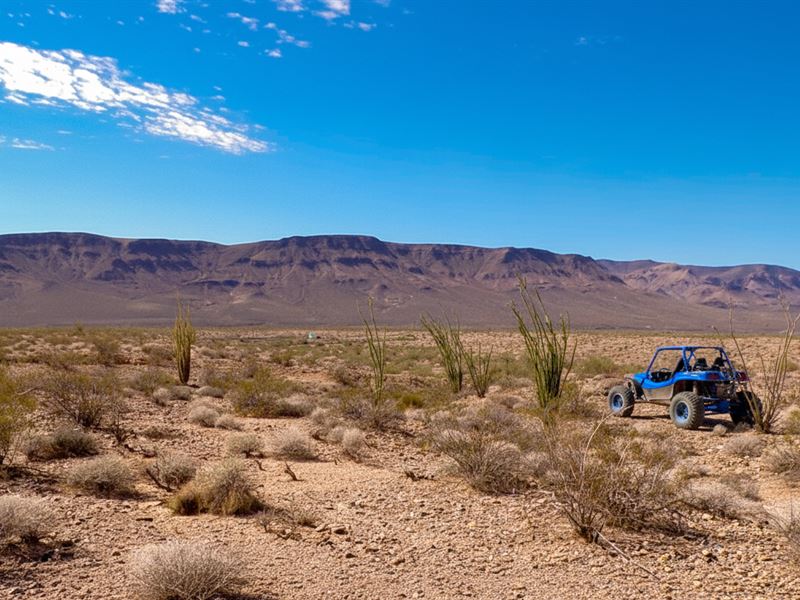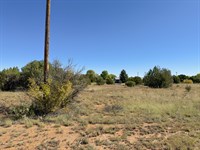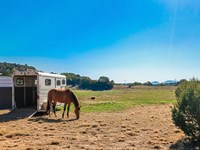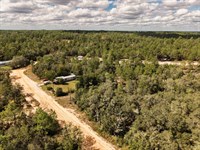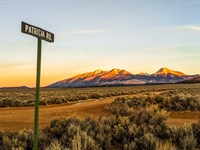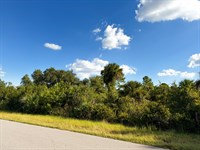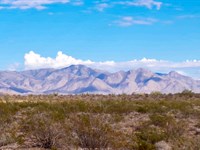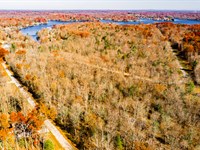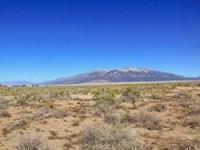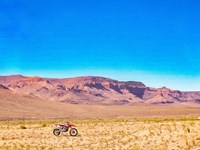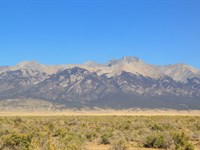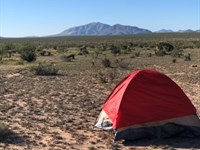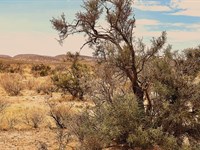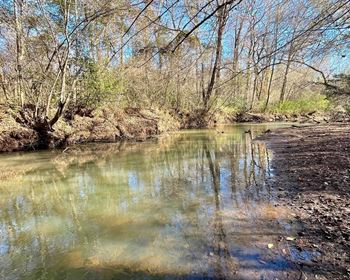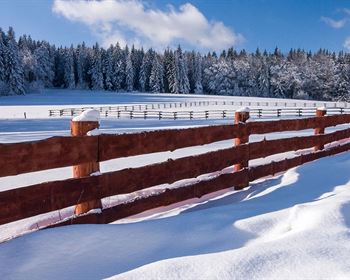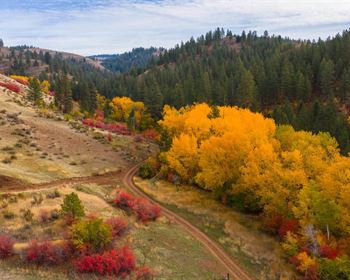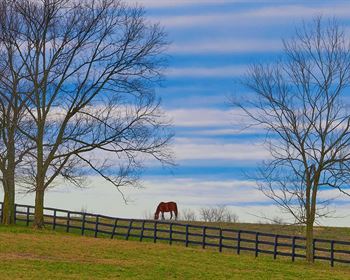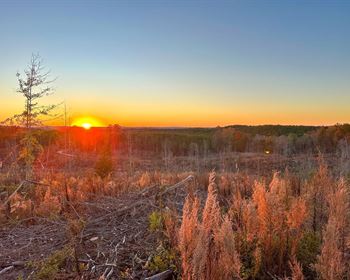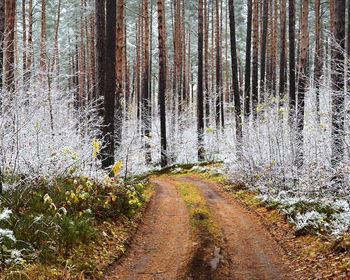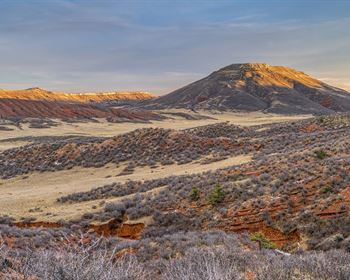Sextuple-Lot, Camp, Build, Roam
Yucca, AZ 86438
Mohave County, Arizona
Land Description
Single lots along this stretch of Edith Street are listed for over $21k. Here, three of the larger 2.36-Acre parcels have already been assembled into one property and priced at $18,900-So you're getting a wide, continuous section of ground for less than the asking price of one neighbor. It reads as one long piece of country with real elbow room, not a typical 1.13-Acre slice.
Up along Edith Street, the land forms a broad, gently sloping bench that's easy to drive onto and walk. With this much frontage, there's room to lay out multiple RV pads, a cabin or two, a shop, and parking without feeling boxed in. As you move north across the property, the ground folds down into a wide sandy arroyo tied into McKenzie Wash, cutting a natural corridor through the back side of the land. After storms it carries water; the rest of the time it's an open interior-space for kids to roam, a tucked-away fire ring, a target lane, or a quieter hangout out of the wind and sun.
The backdrop is classic Mohave country: long views to the Hualapai and surrounding ranges, big sky overhead, and a scattering of off-grid neighbors far enough away that you keep a sense of space. From your gate, you can unload bikes, quads, or a side-by-side and be on miles of back roads and OHV routes within minutes, with larger trail networks and riding areas an easy haul away. When you want water or a change of pace, Lake Havasu and the Colorado River are close enough for day trips, while Kingman and Lake Havasu City cover bigger supply runs, parts stores, and nights out.
As a larger weekend base, a compound-style off-grid setup with room for multiple rigs and structures, or a long-term hold in the corridor between Kingman and Lake Havasu, this triple-lot Havasu Terrace property gives you something rare out here: one deed, one wide stretch of ground, and real room to spread out.
We are open to owner financing as well - here is what that would look like:
- Total Money Down: $599 ($349 downpayment + $250 closing cost)
- Monthly: $353/Month for 72 months
See Info below.
- Subdivision: Havasu Terrace
- State: Az
- County: Mohave
- Zip:
- Size: 7.08
- Parcel: 245-14-123 + 245-14-122 + 245-14-121
- Legal Description: Tract: 1041 Havasu Terrace Unit ONE Lot 123 + 122 + 121
- Approximate Lat/Long Coordinates:
34.8428, -114.1373
34.8411, -114.1373
34.8411, -114.1390 Sw
34.8428, -114.1390 Nw
- Annual Taxes: Approximately 59.52/Year
- Zoning: Agriculture Residential (Ar)
--- No time limit to build
--- Site Built, Modular, Mobile, and Manufactured Homes Allowed
--- Tiny Homes allowed with special permit classified as RV or mobile home.
--- Full-Time RV Living Allowed: RV shall be connected to an approved wastewater disposal system, and obtain a special permit.
--- RV on the Property While I build: Allowed
--- Camping in a RV Allowed: 14 days max each occupancy, 30 days total for calendar year.
- Hoa/Poa: No
- Improvements:
- Access: Edith St
- Water: Would require a well or alternative.
- Sewer: Would require a septic system
- Utilities: Would have to contact UniSource Energy Services or use alternative power.
Information presented in this listing is deemed accurate but is not guaranteed. Buyers are advised to conduct their own due diligence and verify all details independently.
Location And Setting Overview:
- Your Desert Gateway Between Mountains and River: This 7.08-Acre property sits in one of Mohave County's most strategically positioned areas, where the high desert meets genuine Arizona backcountry. You're planted firmly in the Havasu Terrace subdivision, a community that understands the value of space and independence. The property sits at roughly 2,000 feet elevation, placing you in classic Mojave Desert terrain where temperatures stay moderate compared to the low river valleys. From your land, you'll have unobstructed views stretching toward distant mountain ranges, with the Hualapai Mountains visible to the northeast and the rugged peaks of the Bill Williams drainage system defining your southern horizon.
- Five Minutes to Yucca, Twenty Minutes to Lake Havasu City: The town of Yucca sits just five minutes north along Highway 93, offering basic services and that authentic Arizona small-town feel. It's the kind of place where locals wave from their trucks and the gas station clerk knows your coffee order after three visits. When you need more substantial shopping or entertainment, Lake Havasu City is only twenty minutes southwest. That's a quick run for Walmart, Home Depot, medical services, or any specialized supplies your project demands. Havasu gives you access to big-box retail, full-service hospitals, boat launches on the Colorado River, and even the famous London Bridge relocated brick by brick from England. You get the best arrangement possible-genuine seclusion on your acreage with modern conveniences close enough that you're never truly isolated.
- The Colorado River Recreation Corridor: Living here puts you within easy striking distance of the Colorado River's recreational paradise. Lake Havasu stretches for miles with 400 miles of shoreline, offering world-class fishing for striped bass, smallmouth bass, and massive flathead catfish. Boaters from across the Southwest converge on Havasu's warm waters for water skiing, jet skiing, and houseboat adventures. The river towns of Bullhead City and Laughlin sit an hour north, adding even more waterfront options and Nevada's casinos if you want entertainment. Your property gives you a basecamp for water sports without paying waterfront property prices or dealing with tourist crowds right outside your door.
- Highway 93 Corridor Advantages: This property benefits from its position along the US 93 corridor, which is being upgraded to Interstate 11 standards as part of Arizona's long-term infrastructure vision. That means improved roads, better emergency response times, and increasing economic activity flowing through the region. You're connected to Las Vegas in about two hours north, Phoenix roughly three hours southeast, and California's high desert communities within reasonable reach westward. This corridor positioning matters for property values-areas along major transportation routes tend to appreciate faster than remote pockets with limited access. You're buying into a growth corridor while prices remain affordable.
- Sonoran Desert Vegetation and Wildlife: The landscape here showcases the transition between the Mojave and Sonoran deserts, giving you a unique mix of vegetation. Juniper trees dot the higher ground, providing natural shade and rustic character. Creosote bushes spread across the flats, releasing their distinctive rain-scent after summer thunderstorms. You'll find cholla cactus, prickly pear, and if you're lucky, some barrel cactus on the rockier sections. Ocotillo plants wave their spiny arms skyward, erupting with brilliant red blooms after spring rains. This isn't barren wasteland-it's living desert with its own stark beauty.
- The Seasonal Wash Running Through Your Northern Edge: That wash cutting along your northern boundary isn't a liability, it's a natural feature that adds character and wildlife value to your land. Desert washes serve as highways for animals moving through the backcountry. During the summer monsoon season from July through September, these dry channels can roar to life with flash floods, carrying water down from the surrounding high ground. The rest of the year, they're peaceful corridors lined with desert willow trees and smoke trees that provide shade and visual interest. You'll never build in the wash itself, but having it as a natural boundary adds privacy and ensures that section of your land retains its wild character.
Recreational Opportunities:
- Off-Road Paradise at Your Doorstep: Mohave County is off-road heaven, and your Havasu Terrace property puts you in the middle of it. Bureau of Land Management land surrounds much of this area, providing hundreds of thousands of acres of legal riding terrain. You can fire up your Atv, side-by-side, or dirt bike and head out exploring without trailering to some distant recreation area. Old mining roads crisscross the desert, leading to forgotten prospects, scenic overlooks, and hidden canyons. Some folks spend entire weekends exploring and never cover the same ground twice. The terrain varies from flat desert runs where you can open up the throttle to technical rocky washes that test your driving skills.
- Lake Havasu Watersports and Fishing: Twenty minutes gets you to multiple boat launches on Lake Havasu, one of the Southwest's premier watersports destinations. The lake stretches 45 miles behind Parker Dam, creating a massive playground for boaters, fishermen, and water skiers. Striped bass fishing here is legendary-tournament anglers regularly pull in fish over 20 pounds, and the lake record stands at over 50 pounds. You'll also find excellent fishing for largemouth bass, smallmouth bass, channel catfish, and bluegill. The water stays warm enough for swimming from May through October, and plenty of protected coves offer calm water for paddleboarding or kayaking. Many Havasu Terrace residents keep a boat at one of the marinas or on a trailer at their property, making it easy to hit the water whenever the mood strikes.
- Hiking and Backpacking in Surrounding Ranges: The landscape around your property offers excellent hiking opportunities for anyone who enjoys exploring on foot. The Hualapai Mountains rise to the northeast, providing cooler temperatures and different ecosystems as you gain elevation. Trails wind through juniper and pinyon pine forests, eventually reaching high peaks with panoramic views across three states. To the south, the Bill Williams River drainage offers riparian hiking through cottonwood groves and along seasonal streams. For serious backpackers, the Arizona Strip country lies within a few hours' drive north, offering some of the most remote wilderness in the Lower 48.
- Stargazing Under Dark Desert Skies: Living out here means you'll rediscover the night sky. Light pollution is minimal, and on moonless nights, the Milky Way stretches across the heavens in a brilliant band of light. You'll see shooting stars regularly, watch satellites drift silently overhead, and track the planets with simple binoculars. During meteor showers like the Perseids in August or Geminids in December, you can watch dozens of meteors per hour from a lawn chair on your own land. Many desert residents get into amateur astronomy, setting up telescopes to explore deep-sky objects invisible to most Americans living under city lights.
- Rockhounding and Mineral Collecting: Arizona is famous for its mineral wealth, and the desert around your property offers excellent rockhounding opportunities. Old mining districts dot the landscape, and with permission or on public lands, you can search for interesting specimens. Jasper, agate, quartz crystals, and various colorful stones can be found in the washes and on desert pavements. Bring a rock hammer, bucket, and guidebook, and you'll discover treasures you can polish into beautiful display pieces. Some folks even find small amounts of gold in certain areas, panning the gravels of washes that drain mineralized zones. It's not about getting rich-it's about the thrill of discovery and connecting with the geology beneath your feet.
- Target Shooting and Firearms Recreation: Arizona's gun-friendly culture extends to private land ownership. On your own acreage, you can engage in target shooting and firearms practice legally, as long as you do so safely and responsibly. Set up a backstop, establish a safe shooting direction away from any occupied structures, and you have your own private range. Many rural landowners enjoy sighting in rifles before hunting season, practicing with pistols, or introducing friends and family to shooting sports in a controlled environment. Just be mindful of fire danger during dry seasons and always practice proper safety protocols.
- Photography and Nature Observation: The desert landscape provides endless subjects for photography enthusiasts. Sunrise and sunset paint the mountains in shades of gold, crimson, and purple. Spring wildflowers carpet the desert floor in years with good winter rain. Summer thunderstorms create dramatic cloud formations and lightning shows. Wildlife photography opportunities abound if you're patient-set up a water source or game camera to see what visits your land. Even simple smartphone photography captures incredible images in this environment because the lighting is so clean and dramatic. Nature observation extends beyond photography too. Watch for migrating birds in spring and fall, study the adaptations of desert plants, or simply sit quietly and observe the land's rhythms.
Climate And Terrain:
- High Desert Four-Season Climate You'll Actually Enjoy: Your property sits at approximately 2,000 feet elevation, placing you in high desert climate territory. This means you experience genuine four seasons, but without the extremes that make other regions uncomfortable. Summer days from June through August reach 95 to 105 degrees Fahrenheit, which sounds hot but feels manageable due to low humidity. Sweat evaporates instantly, and shade provides real relief. Summer nights cool into the 70s and upper 60s, making sleeping comfortable. Many residents only run air conditioning during peak afternoon hours, relying on natural cooling through open windows and fans in the evening. Fall arrives in September with cooling temperatures and the drama of monsoon thunderstorms. By October, you're enjoying perfect days in the 70s and 80s with cool nights ideal for bonfires. Winter brings mild days typically in the 50s and 60s with nights occasionally dipping below freezing. You might see light frost a dozen mornings per winter, and very rarely a dusting of snow that melts by midday.
- Spring Wildflower Season and Desert Renewal: If winter rains are generous, spring transforms the desert into something almost unrecognizable. Late March through April can bring spectacular wildflower blooms that carpet the ground in Mexican gold poppies, desert lupine, brittlebush, and globe mallow. The desert suddenly explodes with color and pollinators. Even in drier years, the native perennials put on shows-ocotillo erupts with brilliant red flower spikes at branch tips, and various cacti produce stunning blooms in shades of yellow, pink, and red. Spring is also the season when wildlife becomes most active. Birds migrate through, ground squirrels emerge from winter torpor, and you'll see increased activity from all the animals that laid low during cold months. Daytime temperatures in spring range from the 60s to 80s-arguably the most pleasant weather of the year, perfect for outdoor projects and exploration.
- Summer Monsoon Drama and Flash Flood Spectacles: From early July through mid-September, Arizona experiences the monsoon season, which brings the high desert to life. Moisture pushes in from the Gulf of California, and nearly every afternoon, towering thunderheads build on the horizon. Some days they pass by, other days they dump torrential rain, lightning, and sometimes hail on your exact location. These storms are violent but brief-half an inch of rain might fall in 20 minutes, then the sun breaks through again. The desert smells incredible after monsoon rains, a scent called "petrichor" released by creosote bush oils hitting wet ground. That seasonal wash on your property will roar to life during major storms, carrying a chocolate-colored flood of water, rocks, and debris that can last a few hours before subsiding. Watching these floods from safe vantage points is both thrilling and humbling-nature's power on full display. Monsoon season typically delivers three to five inches of your annual eight to ten inches of precipitation.
- Winter Chill Without the Misery: Winter in Mohave County's high desert means you'll wear a jacket, but you won't be shoveling snow or dealing with ice for weeks on end. December through February brings daytime highs mostly in the 50s, occasionally breaking 60 degrees on sunny days. Nights drop to the 30s and occasionally the 20s, and you might see frost on your vehicle windshield a couple dozen mornings. Precipitation in winter comes as gentle rain from Pacific storm systems, occasionally heavy enough to green up the desert and fill the washes temporarily. Snow is rare at this elevation-you might see flurries once or twice a year, and very occasionally an inch or two that melts within a day. Most winter days feature brilliant sunshine that makes 55 degrees feel warm. You'll want a propane heater or wood stove for morning and evening comfort, but heating demands are modest compared to truly cold climates.
- Wind Patterns and Dust Storm Potential: The open desert experiences wind regularly, which you'll learn to appreciate as natural air conditioning in summer. Prevailing winds generally flow from west to east, though patterns vary. Spring tends to be windiest, with occasional days of sustained 20 to 30 mph winds and gusts higher. These winds can kick up dust, and if conditions are right, you might experience a proper dust storm where visibility drops dramatically. These events are rare but memorable. When building, orient your main living spaces away from prevailing winds if possible, and use vegetation or structures as windbreaks. Many long-term residents plant native shrubs or install wind fencing around patios to create protected outdoor spaces. The positive side of wind is that it keeps the air fresh, prevents stagnant conditions, and makes summer heat more bearable.
- Terrain Features and Topographic Character: Your 7.08 acres include varied terrain that adds interest beyond flat desert pavement. The property gently slopes, providing natural drainage, and juniper trees scattered across the landscape offer shade and visual anchors for siting structures. That seasonal wash along the northern boundary creates a natural edge that separates your developed area from wilder ground. The surrounding landscape features classic basin and range topography-relatively flat valley floors interrupted by rugged mountain ranges. Volcanic rock outcrops appear in places, and desert pavement created by centuries of wind action covers many flat areas. Walking the property reveals small washes, subtle elevation changes, and microhabitats where different plants thrive. This topographic diversity means you can choose building sites based on views, sun exposure, wind protection, and personal preference, rather than dealing with uniform flat ground or impossibly steep slopes.
- Soil Composition and Building Characteristics: Desert soils here typically consist of sandy loam mixed with gravel and decomposed granite. Dig down a few feet and you'll likely hit caliche, a cement-like layer of calcium carbonate deposits that forms over thousands of years. Caliche can be challenging to excavate but provides excellent foundation stability once you break through. The sandy nature of surface soils means water drains quickly rather than creating mud bogs, which is ideal for septic leach fields. For gardening, you'll want to amend the native soil with compost and organic matter, or use raised beds filled with quality soil. The native soil lacks organic content and nutrients but makes an excellent base for construction. Erosion is generally not severe on gentle slopes, but if you create bare earth roads or pads, consider gravel or other surface treatments to prevent wind and water from carving channels during heavy rains.
- Fire Danger and Defensible Space Planning: Wildfires are a reality in the Southwest, though the sparse desert vegetation around your property burns less readily than dense forest. Still, during extreme drought and wind conditions, grass fires and brush fires can spread quickly. Creating defensible space around any structures means clearing dried vegetation at least 30 feet from buildings, pruning juniper branches away from structures, and storing firewood and flammable materials away from your home. Gravel or rock landscaping in immediate proximity to buildings eliminates fuel. Keep grass or brush mowed low in areas you want to protect. Have a fire extinguisher rated for all types of fires, and if you'll be living remotely, consider a water storage tank dedicated to fire suppression. Most long-term residents develop a healthy respect for fire danger during dry, windy spring conditions and avoid open burning when conditions are risky.
---
Off-Grid Living Potential:
- Solar Power Excellence in Arizona's Sunshine Belt: Your Havasu Terrace property sits in one of the most solar-friendly regions in North America. With over 300 days of sunshine annually and minimal cloud cover even during winter months, photovoltaic panels here operate at peak efficiency year-round. A properly sized solar array can provide all your electrical needs without grid connection. Most off-grid homesteaders install systems ranging from 4 to 10 kilowatts depending on their consumption patterns and whether they plan to run air conditioning. Modern lithium battery banks store excess production from sunny days, providing power through nights and cloudy periods. The technology has matured dramatically-systems that cost $40,000 a decade ago now run $15,000 to $25,000 for comparable capacity. Federal tax credits offset 30 percent of system costs, and with no monthly electric bills, the payback period runs five to eight years. After that, you're generating free power for decades.
- Water Independence Through Wells or Cistern Systems: Achieving water independence requires choosing your strategy based on budget and preference. Drilling a well gives you unlimited water from your own property, though upfront costs run substantial. Based on well logs from nearby properties, you'd likely hit water between 300 and 600 feet deep, with drilling costs around $15,000 to $30,000 including pump installation. Wells produce truly independent water supplies that never run out. The alternative approach uses large cistern tanks filled by water hauling, either by yourself or through delivery services. A 2,500-Gallon tank costs $2,000 to $3,000 installed, and monthly refills run $100 to $150 depending on your consumption. Many owners start with cistern systems while saving money to drill wells later. Some combine both approaches-a cistern provides immediate water while you take time to properly site and drill a well. Either way, you control your water supply without depending on municipal systems or dealing with monthly utility bills.
- Propane for Cooking, Heating, and Hot Water: Propane provides the perfect fuel for off-grid living. A 500-Gallon propane tank on your property, filled twice yearly, handles all cooking needs plus a tankless water heater and backup heat source. Propane appliances work identically to their natural gas counterparts but run on delivered fuel. Local propane companies service rural Mohave County, and while per-gallon costs run higher than utility natural gas, total annual costs remain reasonable since you're not using propane for electricity generation. Many off-gridders install propane generators as backup power sources when solar production falls short, though with proper battery sizing, generator use stays minimal. A 500-Gallon tank typically lasts six months to a year for a typical household, and bulk propane pricing in rural Arizona runs roughly $2 to $3 per gallon depending on market conditions and delivery distance.
- Septic Systems for Complete Wastewater Independence: Modern septic systems provide reliable, low-maintenance wastewater treatment without any connection to sewer lines. Your property's sandy soil characteristics make it ideal for conventional septic installations. The system consists of a concrete or fiberglass septic tank where solids settle, connected to a drain field where liquid waste percolates into the ground. Properly sized and installed, septic systems function for decades with minimal intervention. You'll pump accumulated solids from the tank every three to five years-a service that costs $300 to $500 and takes an hour. Between pumpings, you simply live normally, and the system handles everything. Avoid chemical drain cleaners that kill beneficial bacteria, and don't flush non-biodegradable items, but otherwise septics are remarkably trouble-free. Achieving complete wastewater independence through septic gives you true freedom from municipal systems.
- Starlink and Cellular Internet Bringing Digital Connectivity: Modern off-grid living no longer means digital isolation. Starlink satellite internet now covers Mohave County comprehensively, delivering broadband speeds of 100 to 200 megabits per second with latency low enough for video calls and streaming. The system consists of a dish mounted on your roof or pole, requiring just 100 watts of power-easily handled by solar systems. Monthly service runs $110 to $120, and the equipment costs around $600 upfront. For many rural residents, Starlink has been transformational, enabling remote work, online education, and entertainment options that weren't feasible with older satellite internet. Cellular coverage in this area varies by carrier, with Verizon generally providing the strongest signal. Cell phone boosters and external antennas can pull in usable signals even in weak coverage zones, and unlimited data plans let you use mobile hotspots for internet access. Between Starlink and cellular options, you can maintain robust digital connectivity while living completely off-grid.
- Food Production and Sustainable Agriculture: Your seven-plus acres provide ample space for food production if you're interested in homesteading. The growing season here is long-essentially year-round for cold-hardy crops, with two main planting seasons in spring and fall. Summer heat challenges some vegetables, but tomatoes, peppers, and melons thrive. Winter allows greens, root vegetables, and brassicas. Most successful desert gardeners use raised beds filled with quality soil and employ shade cloth during peak summer. Drip irrigation fed from cisterns or wells conserves water while keeping plants healthy. Beyond vegetables, fruit trees adapted to desert conditions produce well-pomegranates, figs, and citrus varieties all succeed with proper care. Chickens provide eggs and pest control, and their manure enriches garden soil. Some homesteaders keep dairy goats for milk and cheese, or raise meat rabbits for efficient protein production. The point isn't becoming completely self-sufficient-that's an unrealistic goal for most-but growing some of your own food adds quality to your diet, reduces grocery costs, and connects you to natural cycles.
- Rainwater Harvesting for Supplemental Water: While rainfall here is limited, capturing what does fall makes sense. A 1,000-Square-Foot roof can harvest 600 gallons from a one-inch rain event. During monsoon season, several storms might deliver that much or more, potentially capturing thousands of gallons over the season. Simple rain catchment systems direct roof runoff through gutters into storage tanks. This water works perfectly for gardens, livestock, and dust control. Some owners filter and treat rainwater for household use, though that requires more sophisticated systems. Even without treating it for drinking, captured rainwater extends your cistern supplies and reduces hauling frequency. The infrastructure is straightforward-gutters, downspouts, first-flush diverters to remove initial dirty runoff, and storage tanks. In dry years, catchment might only provide a small percentage of your needs, but in wet years, it can dramatically reduce water costs.
- Alternative Building Methods for Sustainability: Off-grid living often pairs with alternative construction methods that reduce environmental impact and construction costs. Earthbag construction uses polypropylene bags filled with moistened soil, stacked like masonry and rendered with earthen plaster. The technique creates incredibly durable structures with excellent thermal mass. Straw bale construction, where bales form insulated walls covered with stucco, provides superb insulation and can be owner-built with minimal tools. Shipping container homes have gained popularity, offering weather-tight steel structures that can be modified into modern dwellings. Adobe construction using sun-dried mud bricks follows traditions proven over centuries in the Southwest. These methods require more owner labor than conventional construction but dramatically reduce material costs and environmental footprints. Mohave County building officials will work with you on alternative methods as long as you provide engineer-stamped plans showing structural integrity.
Investment And Market Analysis:
- Remarkable Value Proposition at This Price Point: At the current asking price, you're looking at roughly $2,800 per acre for this property. That's extraordinary value when you consider comparable parcels in the region. Similar acreage in Havasu Terrace or surrounding subdivisions frequently lists for $15,000 to $25,000 depending on access and terrain. Properties with better road frontage or closer to Lake Havasu City command even higher prices. You're buying at a price point that provides immediate equity cushion-even if the market stays flat, your purchase price is well below retail comparables. This creates safety for your investment and upside potential if you ever decide to sell. For investors, buying at this basis allows profitable resale through owner financing at higher price points, or holding for long-term appreciation while property taxes of under $60 annually barely register as a carrying cost.
- Mohave County Growth Trends and Demographics: Mohave County has experienced steady population growth over the past two decades, driven by retirees seeking warm weather and affordable living, plus working families priced out of California and Phoenix metro. Lake Havasu City has seen particularly strong growth, with the population increasing from around 40,000 in 2000 to over 57,000 today. This growth spills into surrounding areas as people seek more affordable land in places like Havasu Terrace while still accessing Havasu's services and recreation. The trend shows no signs of reversing-Arizona remains one of America's fastest-growing states, and Mohave County benefits from proximity to Las Vegas, reasonable distance to Phoenix, and significantly lower costs than coastal markets. As more employers embrace remote work, workers can live anywhere with internet access, and many are choosing affordable rural areas with outdoor recreation over expensive urban centers.
- Infrastructure Improvements Driving Accessibility: Major transportation infrastructure projects will improve access throughout the region over coming years. The upgrading of US Highway 93 to Interstate 11 standards between Phoenix and Las Vegas represents billions in investment that directly benefits Mohave County. Better highways mean easier travel, faster emergency response, and more economic activity. The Rancho Santa Fe interchange project on Kingman's east side opens 1,800 acres for development, creating thousands of new jobs in coming years. These infrastructure improvements tend to lift property values throughout surrounding areas as the region becomes more accessible and economically vibrant. Your property sits along this growth corridor, positioned to benefit from improving transportation networks without being so remote that improvements take decades to reach your area.
- Scarcity Factor with Federal Land Dominance: Approximately 70 percent of Mohave County consists of federal lands managed by Blm, National Park Service, or other agencies. This land will never enter private markets, creating permanent scarcity of developable private parcels. As population grows and demand increases, that fixed supply of private land must absorb all development pressure. This scarcity dynamic tends to support land values over long timeframes. Unlike suburban areas where developers can always build outward onto agricultural land, Mohave County's growth is constrained to existing private parcels or the limited lands the county might purchase from federal agencies through special programs. Your 7.08 acres represent real, scarce private land in a county where most territory is permanently off limits to private ownership.
- Owner Financing Creating Multiple Exit Strategies: The ability to offer owner financing when you eventually sell creates powerful exit strategy options. Raw land is hard to finance through banks-most conventional lenders won't touch it. This means retail buyers either need cash or must find seller financing. If you purchase this property with the seller's financing terms and later resell on your own financing at higher prices, you create excellent returns. For example, buying at $20,000 and reselling at $30,000 with $3,000 down and $400 monthly payments over eight years generates over $41,000 in total proceeds-more than double your basis-while earning interest income monthly. Even if you buy cash, offering seller financing when you sell expands your buyer pool dramatically and commands premium pricing since you're solving the financing problem most raw land buyers face.
- Rental and Recreational Income Possibilities: While traditional rental income is unlikely with raw land, creative uses can generate revenue. Some landowners list properties on platforms like Hipcamp or Boondockers Welcome, charging fees for campers to stay on their land. You might earn $25 to $75 per night from campers who want a private spot with views and space rather than crowded campgrounds. If you install basic amenities like a cleared parking area and fire pit, you enhance appeal and pricing. Another option involves leasing the land to RV owners seeking long-term parking and storage-many retirees want somewhere to keep their RVs between trips, and private rural storage can command $100 to $200 monthly. These income streams won't make you wealthy but can offset property taxes and potentially fund infrastructure improvements while you hold the land.
- Tax Advantages of Land Ownership: Land ownership in Arizona carries several tax benefits. Property taxes remain remarkably low-your annual tax bill under $60 barely registers compared to the cost of owning property in states like California, Texas, or the Northeast. Arizona has no state-level property transfer taxes, meaning when you eventually sell, you avoid the hefty percentage fees many states charge on real estate transfers. If you hold the land over a year before selling, any gains qualify for long-term capital gains treatment at federal level, which is taxed more favorably than ordinary income. If you use the property for business purposes-whether that's a home office for remote work or generating rental income-you may be able to deduct related expenses. These tax characteristics make land a tax-efficient asset class compared to many alternatives.
- Comparison to Urban and Suburban Alternatives: Consider what else $20,000 buys in real estate markets today. In most suburban areas, that wouldn't cover a down payment on a median-priced home. In many cities, it might buy you a parking space. Here, it purchases over seven acres of private land with mountain views, recreational access, and genuine development potential. This value equation attracts buyers who recognize that owning tangible real estate-even raw land-beats most alternatives when prices are rational relative to income and other costs. The same mindset that drove homesteading and land settlement throughout American history still operates today: land represents security, opportunity, and legacy that can't be taken away as long as taxes are paid. At this price point, the barrier to entry is low enough that many buyers can participate without overextending financially.
---
Community And Services:
- Yucca's Small-Town Convenience: The town of Yucca sits just five minutes north, providing essential services without urban congestion. You'll find a gas station with convenience store, a couple of local restaurants serving hearty American food, and basic shopping for groceries and supplies. Yucca developed as a railroad town and retains that working-class, unpretentious character. The people here are friendly in that genuine Western way-they'll wave as you pass, help if you're stuck on the roadside, and mind their own business otherwise. For basics like fuel, ice, and emergency supplies, Yucca saves you the twenty-minute drive into Lake Havasu City. The town also has a small post office for mail services, and cellular coverage is decent enough for phone calls and basic internet.
- Lake Havasu City's Full-Service Amenities: When you need serious shopping, medical care, or entertainment, Lake Havasu City delivers everything a small city offers. The population of 57,000 supports Walmart, Safeway, Home Depot, and numerous smaller retailers. You'll find chain restaurants alongside local favorites, brewpubs, and waterfront dining. Havasu Regional Medical Center provides emergency services and full hospital care, with specialists covering most common medical needs. The city has multiple urgent care clinics, dental offices, veterinary clinics, and pharmacies. Educational opportunities include Western Arizona College, and the public schools serve families throughout the region. Banking, legal services, auto repair, feed stores for livestock, and every other service you'd expect from a functional small city exists in Lake Havasu. The London Bridge tourist draw brings in visitors year-round, creating a vibrant commercial environment that keeps businesses thriving.
- Medical Care and Emergency Services: Emergency medical response in this area comes through Mohave County fire districts and ambulance services. Response times to rural properties vary depending on location and unit availability, typically running 15 to 30 minutes for serious emergencies. That reality is part of rural living-you take more responsibility for immediate first aid and handling minor emergencies yourself. Many rural residents maintain substantial first aid supplies and get training in emergency response. For routine medical needs, Lake Havasu City is close enough that you can see doctors, dentists, and specialists without major travel. Havasu Regional Medical Center handles everything from routine care to serious trauma, and if specialized treatment requires higher-level facilities, medical air transport can reach Phoenix or Las Vegas hospitals within an hour when conditions require it.
- Social Connections and Community Networks: Rural Mohave County isn't heavily populated, but the people who live here tend to be resourceful and community-minded. You'll find your neighbors through chance encounters at the gas station, local events, or simply waving when you pass on backroads. Many rural residents connect through online groups and forums focused on specific areas-Facebook groups for Golden Valley, Yucca, and Havasu Terrace allow residents to share information, warnings about weather or fire, and offers to help with projects. The culture values independence but also mutual aid-if you're stuck in sand or your well pump fails, neighbors often appear to lend equipment or advice. This isn't suburban life where you never meet the people next door, but it's also not a place with formal social structures demanding participation. You can be as social or isolated as you prefer.
---
Seasonal Activities And Conclusion:
- Spring Adventures and Wildflower Exploration: As winter loosens its light grip in March, the desert explodes with activity. Wildflower blooms transform the landscape in good rainfall years, with yellow brittlebush, purple lupine, and orange poppies coloring hillsides and washes. Spring is the season for long hikes without heat stress, for exploring old mining roads on ATVs without dust choking you, and for camping under clear skies with perfect nighttime temperatures. Birders flock to the region as migratory species pass through, and photographers capture the soft light of lengthening days illuminating desert landscapes. If you enjoy outdoor recreation without temperature extremes, spring offers the sweet spot between winter's occasional chill and summer's building heat.
- Summer's Monsoon Drama and Water Recreation: When temperatures climb in June, desert residents adjust their rhythms. Outdoor work happens in early morning or evening, while midday is for shade, swimming, or heading to the air-conditioned comfort of town. But summer brings the monsoon's theatrical storms-towering thunderheads building in the afternoon, lightning crackling across the sky, and brief but intense downpours transforming dry washes into rushing rivers. Those who embrace summer's heat enjoy empty trails and solitude, and the nearby Colorado River provides endless cooling opportunities. Boating, swimming, and fishing on Lake Havasu become daily activities for those with water access. Summer nights are warm enough for stargazing without bundling up, and the Milky Way arcs brilliantly overhead once the moon sets.
- Fall's Perfect Weather and Hunting Seasons: September through November might be the desert's finest months. Monsoons taper off, temperatures moderate into the comfortable 70s and 80s, and the quality of light improves daily as the sun angle lowers. Fall is when hunting seasons open-dove hunting in early September brings shotgunners to the desert, followed by archery and rifle seasons for deer and javelina. Even non-hunters appreciate fall's outdoor perfection, ideal for extended camping trips, long ATV expeditions, or simply working on property improvements without fighting heat or cold. The seasonal shift is subtle compared to regions with dramatic fall foliage, but observant people notice the desert's changes-grasses turning golden, cooler nights triggering subtle leaf changes in the few deciduous shrubs, and wildlife patterns shifting.
- Winter's Mild Days and Cozy Evenings: Winter in the high desert means you'll want a jacket and probably some heat source in your dwelling, but you're not battling the brutal cold of northern states. December and January bring occasional rainy days that green the desert and settle dust. Daytime highs in the 50s and low 60s are perfect for outdoor work-not too hot for exertion, not too cold for comfort. Winter is the season when many desert residents tackle construction projects, build infrastructure, or handle heavy labor that would be miserable in July. Evening temperatures dropping into the 30s make fire pits and propane heaters welcome, creating cozy outdoor spaces where you can enjoy the stars while staying warm. Some years bring brief dustings of snow that transform the landscape for a day before melting, adding variety without creating the hazards and hardships of true winter climates.
- Your Next Step Toward Desert Freedom: This property represents something increasingly rare in America-affordable private land with genuine freedom to use it as you see fit. No HOA committees dictating paint colors, no mandatory building timelines, no neighbors close enough to complain about your projects or lifestyle. Just over seven acres of Arizona high desert waiting for your vision, whether that's a weekend camping retreat, a full-time homestead, or a long-term investment you develop gradually over years. The combination of low price, reasonable access, proximity to services, and flexible zoning creates opportunities that won't last forever as population growth and demand continue pushing into rural areas.
The details matter here-$59 annual property taxes mean you can hold this land indefinitely without financial stress. Agricultural-Residential zoning means you can build almost anything from tiny homes to traditional houses, keep animals, garden, and live completely off-grid if you choose. The seasonal wash adds character and wildlife value rather than creating problems. Lake Havasu City's services sit close enough for convenience while you enjoy genuine isolation on your own acreage. This isn't speculation about distant future value; this is tangible land you can walk today, camp on next month, and begin developing immediately if you have resources and vision.
Whether you're seeking independence from urban systems, building a retirement retreat in warm desert sunshine, creating a basecamp for outdoor recreation, or simply investing in real estate that won't burden you financially, this Havasu Terrace property delivers. The opportunity is real, the price is right, and the land is ready. The only question remaining is whether you're ready to claim your piece of Arizona desert and start building the freedom-based lifestyle you've been dreaming about. This is your invitation to stop dreaming and start doing-to own land where your rules apply and your vision matters more than anyone else's opinions.
The details provided in this property listing are believed to be reliable but are not warranted. Prospective buyers should perform their own research and verification of all information before making purchase decisions.
Land Maps & Attachments
Directions to Land
From Kingman, get on I-40 W from Historic Rte 66 and continue for 6.1 miles.
Follow I-40 W for 18.8 miles to exit 25 (Cal-Ari Dr) in Yucca.
Take Alamo Rd to Edith St for 2.2 miles to the property.
More Land Details
Land Price History
More Land from Jon and Valari Burnett
 0.5 AC : $10.5K
0.5 AC : $10.5K 1.2 AC : $14.9K
1.2 AC : $14.9K 0.3 AC : $8.9K
0.3 AC : $8.9K New5.8 AC : $11.9K
New5.8 AC : $11.9K 0.2 AC : $14.9K
0.2 AC : $14.9K New4.7 AC : $14.9K
New4.7 AC : $14.9K 0.6 AC : $13.5K
0.6 AC : $13.5K 1.3 AC : $6.9K
1.3 AC : $6.9K 2.4 AC : $9.9K
2.4 AC : $9.9K 1.3 AC : $6.9K
1.3 AC : $6.9K 20.9 AC : $18.4K
20.9 AC : $18.4K 20 AC : $21.9K
20 AC : $21.9K
